
Original Link: https://www.anandtech.com/show/885
Intel Developer Forum Spring 2002 - Day 4
by Anand Lal Shimpi on February 28, 2002 11:52 PM EST- Posted in
- Trade Shows
With the week almost over, what has been undoubtedly the most exciting conference in the past several months has come to a close. Thanks to Intel and also AMD, this week has been extremely interesting and is a great introduction to the products that will be coming out later this year and into 2003. This will be one of our two final pieces on the conference after which things will return to normal as I begin the benchmark frenzy on some of the hardware and technologies discussed over the past few days.
AMD and Intel talk CPUs
We learned a bit more about the future of both AMD's and Intel's CPUs from talking to representatives from both companies as well as piecing together a bit of information on our own.
First let's start with AMD; remember Barton, the 0.13-micron Silicon on Insulator part? The purpose for that chip was to enable the 0.13-micron SOI technology and with ClawHammer moving along as planned, AMD is reevaluating its need in the market. As we've speculated for quite a while, it doesn't seem as if there will be any major architectural improvements with the 0.13-micron Thoroughbred core although AMD has told us that they aren't opposed to evaluating any changes that could be made. The only one we can think of is adding additional cache to the die but considering that AMD's performance is already very strong and that they are still manufacturing on 8" wafers, keeping their die as small as possible is probably in their best interests. As far as Hammer naming goes we have no reason to believe that the desktop version won't be branded as some sort of Athlon although the enterprise level solutions may get a new brand.
On the Intel side of things we completely forgot to mention one very important characteristic of Prescott yesterday. If you'll remember back to our BBUL technology article we gave a little preview of the FSB frequencies of future Intel processors - with Prescott coming in with an 800MHz FSB (presumably 200MHz quad-pumped). As far as other enhancements go, the move to a 0.09-micron manufacturing process will reduce the current Northwood die size by about half leaving quite a bit of room for additional architectural enhancements. Some theories we had included offering more cache (768KB or 1MB?) and maybe even moving to 32-bit ALUs instead of the current 16-bit units. The latter would make sense since Intel has been demonstrating high-speed 32-bit ALUs for quite a while now.
If both of these hold true, it means that the only CPUs that will be released over the next few months will be simply speed bumps until the Hammer is officially released.
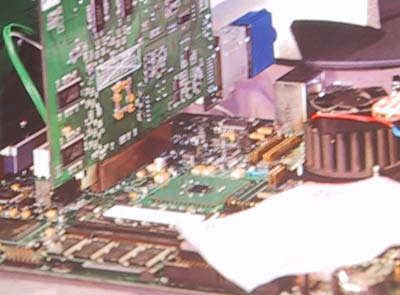
The world's first display of the upcoming Banias chipset (Odem) running with
a Northwood
During Anand Chandrasekher's keynote, he demonstrated the world's first Banias platform - the chipset is codenamed Odem. As you'll remember from previous IDF conferences, Banias is Intel's first CPU that has been designed from the ground up to be a mobile CPU. Designed by Intel's team in Israel, Banias is supposed to truly bring high performance and mobility together in a CPU aimed at making the perfect notebook. Banias will be a departure from anything we've ever seen from Intel in the past and will have quite a bit to do with wireless technology but we'll leave it at that until closer to Banias' 2003 release.
Forget Serial ATA, it's time for Serial ATA II
From a distance this display was a bit hard to believe, after all why would anyone want to start promoting Serial ATA II when Serial ATA is still around a year away from mass market introduction?
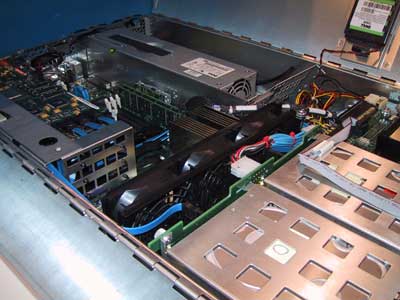
It turns out that when Serial ATA was being developed little attention was given to using the standard in servers, mainly because IDE never had much of a presence there. This raised a number of issues which are supposed to be addressed by Serial ATA II. The successor to the Serial ATA spec will support features like command queuing and obviously hot-swap capabilities aimed entirely at the server market, but there's even more.
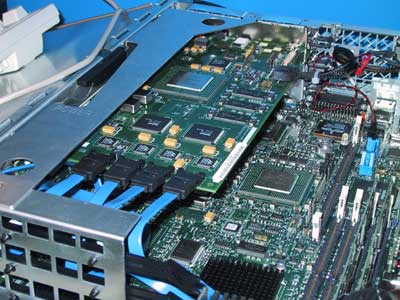
A 4-channel Adaptec Serial ATA RAID card
One of the challenges you run into with a multi-drive Serial ATA RAID array is that you'll need to have a port for every drive in the array. This means we'll either need cards with an infinite number of ports or there has to be a better way of doing this.
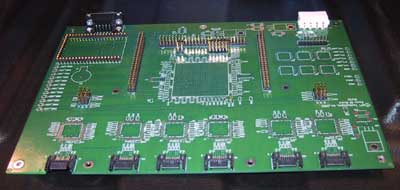
This is a large scale concept of what a Serial ATA switch would look like, the
real thing would be much smaller
Part of the Serial ATA II specification is the support for switching logic to allow for an unlimited number of drives to be connected to one or more host ports. This way, if you run out of ports on your motherboard or RAID card then all you'll have to do is plug in a switch with more ports to solve your problems.
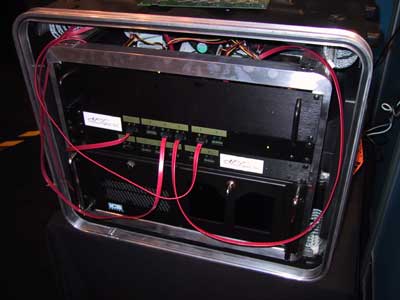
Intel's demonstration of a Serial ATA switch in action, the real thing would
be tremendously reduced in size obviously in order to fit within a case
Each port on these switches would function as either a connection to the host controller or a drive, and the switch will be intelligent enough to even distribute bandwidth among the ports.
Connecting LCDs with Fiber
One of the biggest problems with notebook displays is that the connection between the graphics chip and the LCD display is made using a custom made copper connector. These custom connectors have relatively large cable widths of around 1" at least and are not very flexible at all; they can usually be bent along one axis but try to do it along the other and you'll be looking for a replacement real soon. Since these cables are custom made for each laptop design it's not as easy to replace as a VGA or DVI cable on your PC since the length and layout of each cable varies from one notebook to the next.
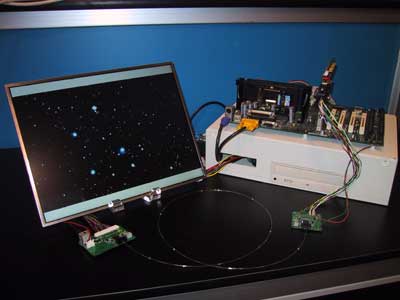
The plastic cabling you see here is all that is necessary to transmit a high-bandwidth
video signal from GPU to display
A company called Photonage has developed a solution to this problem - developing a fiber optic cabling standard instead of the proprietary copper connections that are used today.
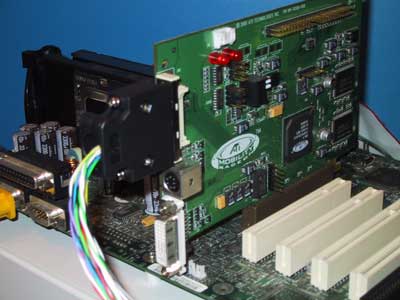
For demonstration purposes a desktop Pentium III system was used with an ATI Mobility Radeon AGP adapter card. Plugged into the DVI connector was a custom adapter that wouldn't normally be used since there are no DVI connectors inside your laptop.
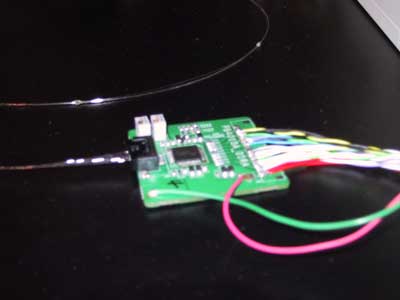
The signal is then sent to this chip and is outputted through this plastic fiber optic cable. The actual implementation of this technology will be barely any larger than the IC in the center of the above PCB.
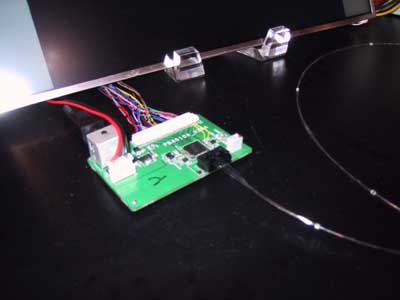
Here the signal enters the LCD display.
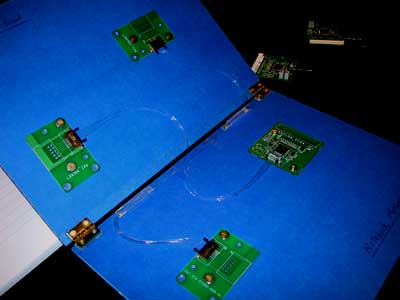
One of the benefits of this connection is durability and ease of routing. This should allow for much greater flexibility by notebook vendors to design even more unique laptops. Intel has officially supported this technology as what they're encouraging notebook manufacturers to use in the future.
Making servers that work
With the release of the Intel E7500 chipset many have been saying that Intel will be stealing a great deal of market away from ServerWorks, the Broadcom company who has been manufacturing Intel's enterprise chipsets for the past several years; ServerWorks doesn't seem to agree. Not only is ServerWorks claiming higher performance out of their Grand Champion (GC) series of chipsets but they're claiming significantly higher performance with extremely high-end PCI-X I/O setups.
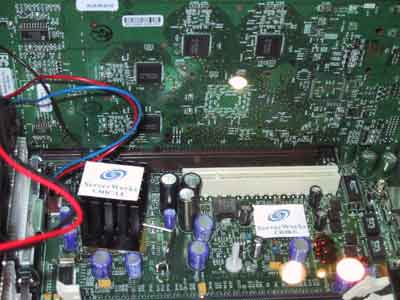
Peering into a GC-LE Workstation with a Quadro4
The ServerWorks GC-LE, for example, does have significantly more bandwidth to its PCI-X bridge and supports simultaneous bi-directional data transfers which could give it the edge over the E7500. The real question is under what circumstances does this bandwidth advantage matter? Without the ability to test a 120+ drive RAID array we can't pinpoint the exact circumstances in which the performance would vary by a noticeable amount but we're working with ServerWorks on performing some sort of a comparison between the two competing platforms in the future.
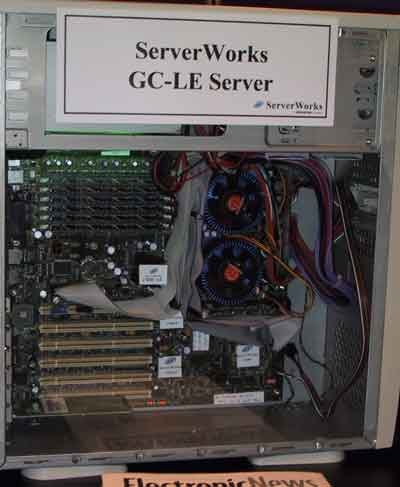
The GC-HE chipset offers support for up to 4 CPUs but in this case is used in
a 2-way server
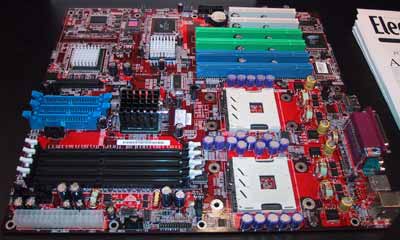
The rest of ServerWorks' booth was pretty much the same as what we had seen at previous IDF conferences with the exception of the board pictured above based on the GC-SL chipset. The GC-SL will be aimed at the 2-way entry-level server market and thus is absent of some of the features that make the rest of the GC line so very attractive. The biggest limitation is the fact that it only features a 64-bit DDR memory bus instead of the dual and quad 64-bit DDR channels present in the GC-LE and GC-HE chipsets.
What lies in the future for ServerWorks? Right now it's obvious that these chipsets are composed of entirely too many individual chips, so going forward there will most likely be a focus on heavy integration of the functions of many of these independent chips (PCI-X bridges, Gigabit Ethernet controllers, etc...) into single pieces of Silicon. This will not only make the job of the motherboard manufacturer easier but it will also reduce the overall costs of the chipsets.
Lecta - The '03 PC
We introduced you to the Lecta platform in our Day 3 coverage of IDF and now we're able to bring you some pictures from inside the case.
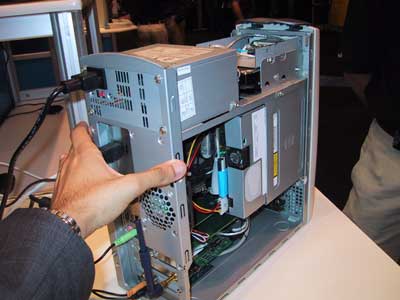
First and foremost you can tell that Lecta isn't a big design at all; the chassis is designed to be very compact and you can already tell that it's not as small as it could possibly be. With innovations such as a reduced size power supply with a greater power density the design could be reduced even more. That will come in due time but the fact that this is a 2003 concept design is definitely impressive. Seeing this brings an appreciation of exactly how far innovation has taken us in the past decade, remember the cases our 286s and 386s came in?
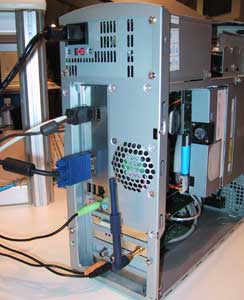
The rear of Lecta also tells a story we've been waiting to hear - it's truly legacy free. There are no serial ports, no parallel port and no less than 8 USB 2.0 ports; this achieved using a USB 2.0 hub in conjunction with Intel's ICH4 that's present on the motherboard (ICH4 features an integrated USB 2.0 controller that supports 6 ports).
There's an onboard 10/100 Ethernet port and the antenna sticking out of the case is an 802.11a wireless receiver.

Inside this '03 concept PC is a flash memory card reader as well as a Serial ATA hard drive. By 2003 the transition to Serial ATA should be in full force.
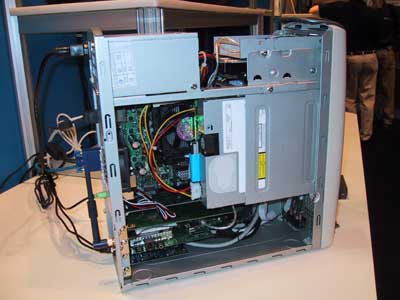
You can see by the profile of the Lecta concept PC that there aren't many cables running around. Remember that in the keynote where Lecta was demonstrated the CPU was moved to the front of the chassis which isn't the case (no pun intended) here. By the time the Lecta prototype is complete you can expect that along with many other modifications to be made.
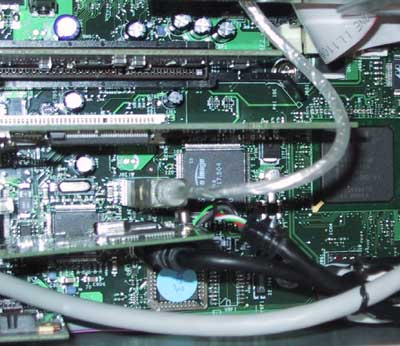
Delving a bit deeper into the case we see two things: ICH4 on the left which will be making its public debut later this year in Intel chipsets, and a Silicon Image Serial ATA controller which is driving the Serial ATA hard drive. The DVD-RW present in the system isn't Serial ATA mainly because of a present lack of Serial ATA devices that should change by 2003.







